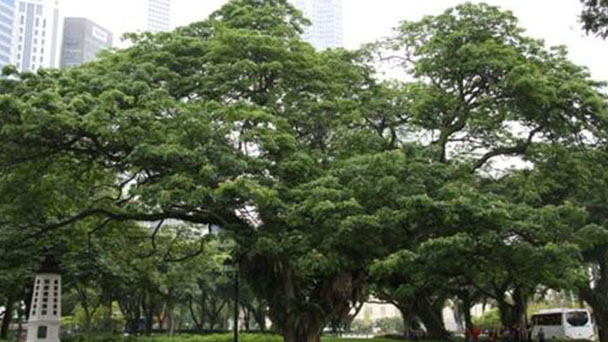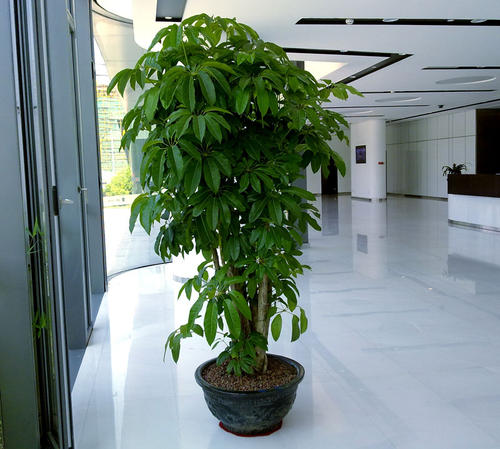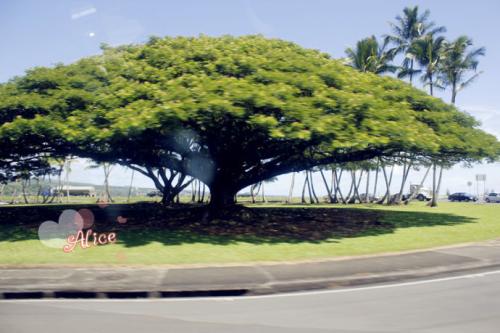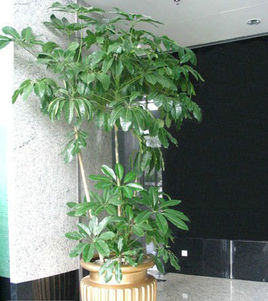Schefflera actinophylla (Umbrella plant) profile
Written by Maggie
Oct 19 2021

Umbrella Plant, scientific name Schefflera actinophylla, belongs to Angiosperm phylum, Dicotyledona class, Rosa subclass and Umbrella order. Umbrella Plant is an evergreen tree native to Australia, with a symmetric Umbrella crown and leaves arranged into rosettes at the end of branches.
The leaves of umbrella trees are closely alternate, arranged in a wheel-like pattern; Compound leaves, leaflets from a radial petiole, like an open umbrella. When a tree is young, it has only three leaflets; At maturity, the number of leaflets may be as many as 12 or more.
Umbrella Plant is an evergreen tree native to Australia.
Umbrella plant picture

The morphological features of umbrella plant
The leaves of a Umbrella Plant are closely interconnected and arranged in a wheel pattern; Compound leaves, leaflets from a radial petiole, like an open umbrella. When a tree is young, it has only three leaflets; At maturity, the number of leaflets may be as many as 12 or more.
Although the appearance of the leaves of the umbrella tree is similar to that of the duck foot tree, the duck foot tree usually has only eight or less leaflets, so it is easy to identify.
Schefflera actinophylla is also known as the Umbrella Plant because the red spikes that form a palmate arrangement when it blossoms look like Umbrella bones when it opens from a distance, and because these spikes look like the open tentacles of an octopus.
The whole plant belongs to the family Acanthaceae and can reach a height of 30 meters. Umbrella Plant is a leafy evergreen tree with a symmetrical umbrella crown. Branches are less branched. The bark is grey and slightly rough in texture.
Leaves: Leaves are alternate and arranged in a wheel-like arrangement; Compound leaves, leaflets arising from radiate petioles, up to 12 or more at maturity. The leaflets are oblong and can grow up to 30 cm long. Leaf tip is obtuse, base acuminate, margin serrate. The texture is soft and changes from yellowish green to dark blue-green when ripe.
Flowers: Flowers of Umbrella Plant are red, small, sessile, dense, consisting of five petals. A palmate terminal spike, like the bone of an umbrella when open.
Fruit: Umbrella Plant fruit is purplish red berry, soft texture, sessile.Inflorescences densely clustered along spikes.
The propagation mode of umbrella plant
The branches of Umbrella Plant are covered with fruit pods, which contain some prickly fruit. Its branches are also extremely elastic, with a strong tension; When a running animal touches a branch, it bounces back and wraps itself around the animal. At the same time, its ripe fruit pods burst open, and the prickly fruit penetrates the animal's skin like shrapnel. The more the animals struggled, the tighter they became, and some died as a result. When the body decays, the seeds fall into the soil and continue to take root and germinate.
Distribution area of umbrella plant
Umbrella Plant is an evergreen tree native to Australia. Although the appearance of the leaves of the umbrella tree is similar to that of the duck foot tree, the duck foot tree usually has only eight or less leaflets, so it is easy to identify.

How to grow and care for umbrella plant
Light
Umbrella Plant likes sufficient sunshine, but the sunshine around noon from spring to autumn should be avoided properly, otherwise the leaves will lose their luster, and in severe cases, the leaves will turn yellow and fall off.
Watering
In the growing period of Umbrella Plant, sufficient water should be kept, and the soil should be kept in a moist state, especially in summer, when the growth is most vigorous. However, the soil should not be too wet, as this will cause the Plant leaves to lose their vitality, or even cause the leaves to fall off or rot the roots.Winter to reduce the amount of watering, let the soil to keep dry.
Fertilization
During the growing period of Umbrella Plant, fertilizer can be used once or twice a month. Nitrogen fertilizer can be used to make the Plant grow quickly and make the leaves dark green and bright. Arriving after autumn to want to convert potassium amount to be in the majority of, can strengthen the plant to be right so colder weather adaptation. Fertilization should be suspended in winter.
The temperature
The most suitable temperature for the growth of Umbrella Plant is 20 ℃ to 30 ℃. The excessively high temperature in summer and the temperature below 5 ℃ in winter are very unfavorable to the growth of Umbrella Plant. It is best to breed indoors in winter, and the best temperature is 18 degrees to 20 degrees.
Pruning
Umbrella Plant easy germination long branches, usually pay attention to plastic pruning, in order to promote the initiation of lateral branches, maintain a good tree shape. Young plants for shearing and light shearing, mainly modeling. When old plant physique is too huge, can combine to change a basin to undertake re - cut, cut off major branches, also must cut root part at the same time, afresh potted plant, make new leaf germinate.
Potting and Repotting
Repot the plants annually, or as needed. You can slow the growth rate and prevent plants from getting too large by prolonging the period between repotting and allowing them to get somewhat rootbound.
Umbrella plant toxicity
Umbrella plants are toxic because they contain calcium oxalate crystals, which are in the SAP of the umbrella plant, which means it's in all parts of the factory. The SAP causes mild skin irritation that usually lasts only a few minutes. If you have any liquid on your skin, wash immediately with soap and water.Wear gloves when working with the factory.
Umbrella plant symptoms of poisoning
Chewing any parts of this plant will create a stinging, burning sensation, so it's fairly rare for humans to eat enough to experience serious problems. In pets, symptoms include drooling, vomiting, mouth pain, and lack of appetite. There is also the potential for long-term kidney damage.
Umbrella plant varieties
Of the many species in the Scheffler genus, two are common houseplants:
Schefflera actinophylla: The most common Schefflera, it has oval leaves that grow up to 10 inches from a central stalk. It can be quite a large 50-foot specimen outdoors, but indoor potted specimens usually top out at 15 feet.
S. arboricola: This smaller version, popular in home gardens, has 1- to 2-inch leaves that grow in tight clusters; it is a variegated variety of this plant, with creamy blotches on its leaves. It can grow as high as 25 feet outdoors, but houseplants are normally kept to no more than 6 feet.
Umbrella plant main value
In the tropics, Umbrella plants are often grown for ornamental purposes.

Read Next: Schefflera Propagation Methods
Latest Updated
- Benefits of Bugleweed - 7 Science-backed Health Benefits
- Bugleweed Dangers & Side Effects - Is It Poisonous?
- How to Plant Evergreen Trees - What You Should Know
- When to Plant Evergreens - Grow Guide for Evergreen Trees
- 12 Wonderful Evergreen Shrubs for Your Garden
- 12 Popular Evergreen Plants with Pictures for Beginners
- When And How To Prune A Lilac Bush Like a Pro
- How to Grow & Care for Lilac Vine (Hardenbergia Violacea)
- Japanese Lilac Tree (Syringa Reticulata) Care & Propagation Guide
- Shumard Oak Pros and Cons - What to Know
Popular Articles
- Winter maintenance of Antirrhinum Majus
- How to Grow Terminalia Mantaly Tree
- How to Grow and Care for Crossostephium Chinense
- How to grow Antirrhinum Majus in spring
- Peristeria Elata (Dove Orchid) Profile: Info & Care Guide
- Underwatered Snake Plant (Sansevieria Trifasciata) - Signs And How To Fix
- How to Care for Brazilian Jasmine Plant (Mandevilla Sanderi)
- How to Grow & Care for Graptopetalum Purple Delight in Summer
- Rosa Chinensis (China Rose): Plant Growing & Care Tips
- How to Care for Baby Sun Rose (Aptenia Cordifolia)